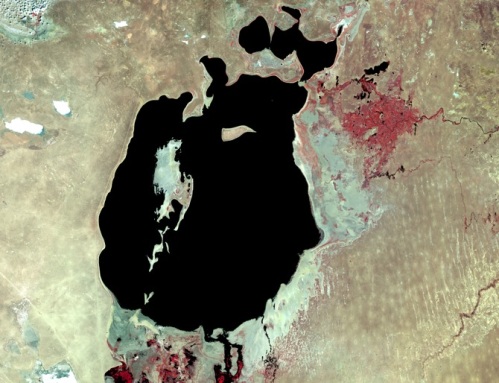I picked up these images at Wired two days ago and just could not fit in the time to put them up earlier.
There is a remarkable quote by Einstein –
“Two things are infinite: the universe and human stupidity; and I’m not sure about the the universe.”
It isn’t definite to me if I liked this quotation earlier. But I am NOW wholly convinced that I love it. And this new found unequivocalness for it is due to the following:
As a kid, I used to have a large collection of encyclopedias. I remember reading about the Aral Sea in the picture atlas, and that it mentioned that there was increasing salination of the sea water and that it would disappear in some decades.
Over the years that time, we were fed with doomsday scenarios all the while. Like all the coastal cities would be soon under sea due to rising ocean levels, and that the Himalayas would soon be ice free etc etc. Over a period of time you get fed up with such idle talk and since you don’t see anyone giving convincing answers, you tend to believe that nothing like that is true. Secondly, the eternal optimist that I am, I just probably wished that what that encyclopedia said about the Aral was some “minor” problem.
I last read about the problem many years ago and after that never came across anything on it. And just a couple of days back was shocked by these images. I have only one word for them : Tragic!
The images are from 1973, 1987, 1999, 2006 and 2009. The two recent images were released by the European Space Agency, the earlier ones were taken by the United States Geological Survey.

Aral Sea - 1973

Aral Sea - 1987

Aral Sea - 1999

Aral Sea - 2006

Aral Sea - 2009
[Image(s) Source : Wired Science]
The South Aral Sea, the remnant of the original lake that you can see to your left on the above image is also expected to vanish by 2020, thankfully the North Aral sea (the part on the right) has been saved due to a world bank funded dam project.
The Aral sea, once the world’s fourth largest lake at roughly around 68,000 sq kms is now just about one-tenth that size. The trouble started when it was decided by the Soviets in 1918 that the two rivers that drained into the Aral – The Amu Darya and Syr Darya would be largely diverted to the deserts to develop them into cotton growing lands. The Soviet plan worked and cotton became one of the most important exports from that area. By the 1960s massive amount of water was being diverted and the sea began to shrink steadily. And how that happened is spoken out loud by the pictures.
The death of the Aral is extremely sad. It’s death has left it’s once thriving fishing industry destroyed, the diverting of the rivers has mostly reduced the two rivers to a shadow of their former selves. The Aral served as a climate moderator in the largely arid lands there, it’s death might herald major environmental catastrophe in the region.
This is a prime example of what human stupidity could lead to and leaves me short of words to describe my anguish at the same.
It has a number of things to say:
Ignoring warnings which have clear proof is just plain stupidity. There is ample proof for example of climate change and its bad impact. For example, I have been visiting the Himalayas once every few years since 1991. And the change there is apparent, as compared to the 80s the glaciers that make up the Ganges have shrunk by several kilometers. I don’t know what the solutions are, nor am I comparing the Aral problem with it. I understand that the Aral was a different kind of a problem. Different because it was known to the Soviets that the lake would dry up from the start. Climate change can not be compared to it as we do not yet fully understand a number of things about it, so how effective the correctives would be is debatable. It would be for our good if that debate is settled soon with good and incisive scientific evidence.
It also is a comment on how totalitarian regimes can be dangerous. In such regimes, since a decision taken can not be opposed, such a decision could either lead to major dividends/progress as it would be implemented very rapidly or major catastrophe as was in the above case. Soviet officials were aware that the Aral would sooner or later evaporate. In 1964 Aleksandr Asarin noted that :
“It was part of the five-year plans, approved by the council of ministers and the Politburo. Nobody on a lower level would dare to say a word contradicting those plans, even if it was the fate of the Aral Sea.”
Ofcourse he was right, there is rarely any way to convince or reason with or oppose supercilious totalitarian regimes even if their decisions are clearly suicidal. I am tempted to make a political comment on two present day countries (one a totalitarian state and one a liberal democracy) here, but would avoid the temptation.
Anyhow, the images above disturbed me enough to lose sleep.
_____



